Yu-Han Chao's Blog, page 6
May 19, 2019
4.18. Gratitude, Remembering the Dead, & Pokemon
Our last nursing school exam, many of us lingered in our usual seats with our 100-question, filled-out scantrons far longer than necessary, because for how long these past two years were, at this final moment, we suddenly weren't quite ready for it all to end.
 Pretty sure this is what our pinning ceremony will look like.
Pretty sure this is what our pinning ceremony will look like.
We have so many people to thank--one another, those who have been there with us, taught us, who helped us survive in some way, who watched our children, who are our children, those who gave us life or in some cases, saved our lives, literally or metaphorically, because first, there's living, and then, there's living life.
Becoming a nurse reminds us every day that life is short, unpredictable, and we should make every moment count.
And we remember and honor our dead, too. They say that every person you lose, they take a little bit of you with them, and you, in turn, keep a little bit of them. Not sure what it says about me that all my dead seem to come back to me as Pokemon. Yes, someone (not going say who) has a little Pokemon Go problem. These beautiful squirrels here remind me of my late mother. Something about the bangs, curly ponytail, round eyes, perhaps. Also, one of her common sayings was _ _就火冒三丈, this makes the flames of my anger rise ten meters high, so the fire-type Vulpix is perfect, and the wan-faced, albino counterpart works, too. Because--ghost. Part of my superstition around my Mom visiting me through Vulpix appearances is, without playing Pokemon more than usual (which isn't saying much), I've caught one of these not-that-common creatures every important day since she passed, including the day I submitted my RN application, at my brother's wedding, my book launch/grandpa's passing, etc.
These beautiful squirrels here remind me of my late mother. Something about the bangs, curly ponytail, round eyes, perhaps. Also, one of her common sayings was _ _就火冒三丈, this makes the flames of my anger rise ten meters high, so the fire-type Vulpix is perfect, and the wan-faced, albino counterpart works, too. Because--ghost. Part of my superstition around my Mom visiting me through Vulpix appearances is, without playing Pokemon more than usual (which isn't saying much), I've caught one of these not-that-common creatures every important day since she passed, including the day I submitted my RN application, at my brother's wedding, my book launch/grandpa's passing, etc.
 My beloved Pingtung Grandpa, who just passed away in Taiwan last month, is naturally, a legendary. The black markings remind me of his beautiful calligraphy. He had that same, stern look, but was always kind to us children (not to random Other People's Children who were misbehaving in public, though.) He was a military man, a veterinarian, and his daughter was once a nurse (who talked her brother, my dad, out of becoming a doctor, many moons ago.)
My beloved Pingtung Grandpa, who just passed away in Taiwan last month, is naturally, a legendary. The black markings remind me of his beautiful calligraphy. He had that same, stern look, but was always kind to us children (not to random Other People's Children who were misbehaving in public, though.) He was a military man, a veterinarian, and his daughter was once a nurse (who talked her brother, my dad, out of becoming a doctor, many moons ago.)
 Another recent loss, poor Domo-Domo, was a former stray cat like Meowth. He really wasn't the sharpest (or nicest-smelling) kitty you ever met and was an absolute klutz, but he was probably pretty misunderstood, including by our older Siamese who hazed him like nothing else when he first arrived from the kill shelter after farting the entire car ride home. (Poor little dude always had a sensitive stomach.) Eventually, Old Kitty allowed Domo to quietly snuggle up against him after he was asleep. Domo was never quite the same after Old Kitty died; he always seemed to be waiting, wondering, a little sad. At least the two of them are reunited now.
Another recent loss, poor Domo-Domo, was a former stray cat like Meowth. He really wasn't the sharpest (or nicest-smelling) kitty you ever met and was an absolute klutz, but he was probably pretty misunderstood, including by our older Siamese who hazed him like nothing else when he first arrived from the kill shelter after farting the entire car ride home. (Poor little dude always had a sensitive stomach.) Eventually, Old Kitty allowed Domo to quietly snuggle up against him after he was asleep. Domo was never quite the same after Old Kitty died; he always seemed to be waiting, wondering, a little sad. At least the two of them are reunited now.
 Pretty sure this is what our pinning ceremony will look like.
Pretty sure this is what our pinning ceremony will look like.We have so many people to thank--one another, those who have been there with us, taught us, who helped us survive in some way, who watched our children, who are our children, those who gave us life or in some cases, saved our lives, literally or metaphorically, because first, there's living, and then, there's living life.
Becoming a nurse reminds us every day that life is short, unpredictable, and we should make every moment count.
And we remember and honor our dead, too. They say that every person you lose, they take a little bit of you with them, and you, in turn, keep a little bit of them. Not sure what it says about me that all my dead seem to come back to me as Pokemon. Yes, someone (not going say who) has a little Pokemon Go problem.
 These beautiful squirrels here remind me of my late mother. Something about the bangs, curly ponytail, round eyes, perhaps. Also, one of her common sayings was _ _就火冒三丈, this makes the flames of my anger rise ten meters high, so the fire-type Vulpix is perfect, and the wan-faced, albino counterpart works, too. Because--ghost. Part of my superstition around my Mom visiting me through Vulpix appearances is, without playing Pokemon more than usual (which isn't saying much), I've caught one of these not-that-common creatures every important day since she passed, including the day I submitted my RN application, at my brother's wedding, my book launch/grandpa's passing, etc.
These beautiful squirrels here remind me of my late mother. Something about the bangs, curly ponytail, round eyes, perhaps. Also, one of her common sayings was _ _就火冒三丈, this makes the flames of my anger rise ten meters high, so the fire-type Vulpix is perfect, and the wan-faced, albino counterpart works, too. Because--ghost. Part of my superstition around my Mom visiting me through Vulpix appearances is, without playing Pokemon more than usual (which isn't saying much), I've caught one of these not-that-common creatures every important day since she passed, including the day I submitted my RN application, at my brother's wedding, my book launch/grandpa's passing, etc. My beloved Pingtung Grandpa, who just passed away in Taiwan last month, is naturally, a legendary. The black markings remind me of his beautiful calligraphy. He had that same, stern look, but was always kind to us children (not to random Other People's Children who were misbehaving in public, though.) He was a military man, a veterinarian, and his daughter was once a nurse (who talked her brother, my dad, out of becoming a doctor, many moons ago.)
My beloved Pingtung Grandpa, who just passed away in Taiwan last month, is naturally, a legendary. The black markings remind me of his beautiful calligraphy. He had that same, stern look, but was always kind to us children (not to random Other People's Children who were misbehaving in public, though.) He was a military man, a veterinarian, and his daughter was once a nurse (who talked her brother, my dad, out of becoming a doctor, many moons ago.)
 Another recent loss, poor Domo-Domo, was a former stray cat like Meowth. He really wasn't the sharpest (or nicest-smelling) kitty you ever met and was an absolute klutz, but he was probably pretty misunderstood, including by our older Siamese who hazed him like nothing else when he first arrived from the kill shelter after farting the entire car ride home. (Poor little dude always had a sensitive stomach.) Eventually, Old Kitty allowed Domo to quietly snuggle up against him after he was asleep. Domo was never quite the same after Old Kitty died; he always seemed to be waiting, wondering, a little sad. At least the two of them are reunited now.
Another recent loss, poor Domo-Domo, was a former stray cat like Meowth. He really wasn't the sharpest (or nicest-smelling) kitty you ever met and was an absolute klutz, but he was probably pretty misunderstood, including by our older Siamese who hazed him like nothing else when he first arrived from the kill shelter after farting the entire car ride home. (Poor little dude always had a sensitive stomach.) Eventually, Old Kitty allowed Domo to quietly snuggle up against him after he was asleep. Domo was never quite the same after Old Kitty died; he always seemed to be waiting, wondering, a little sad. At least the two of them are reunited now.
Published on May 19, 2019 11:55
May 11, 2019
4.17. Giving Birth Dream
It's that time in the semester for Really Weird dreams. This happens to be a Giving Birth dream, which I'm sure has something to do with my regretting not studying my OB book for a particular, recent, exam.
In my dream I am pregnant, and am just considering Hey, Google-ing or using Nagele's rule to figure out when my due date is (although of course I don't remember the first day of my last menstrual perod), I feel a bit of pressure Down There, something slippery come out, and I reach down.
I have given birth to an intact bag of waters, baby suspended inside. The bag, incidentally, is a 1000ml IV bag of 0.9% normal saline, so I know it's sterile.
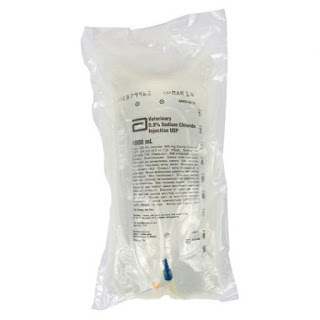 Instead of calling an instructor, or doctor, or 911, I try calling one of my classmates who precepted in OB. The call goes to voicemail.
Instead of calling an instructor, or doctor, or 911, I try calling one of my classmates who precepted in OB. The call goes to voicemail.
My daughter comes up, concerned, and I calmly ask her to get some towels.
I wonder if there are still sterile gloves lying around somewhere from when we took them home from lab to practice first semester. I need to keep the cord moist. I'm not going to have anything sterile enough to poke the bag, which is actually pretty darn thick, because this saline bag baby came double bagged--in the regular IV bag plus the thick plastic bags they come in, which I always have a hard time ripping.
How do I keep the entire bag and baby warm? Nothing is clean or warm enough, and here comes my duaghter, dragging along the carpet and grimy linoleum the same bath towel I wrapped around her after her bath earlier.
At this point in the dream I turn back to the internet.
Hey Google, what do I do if I give birth and the baby's still in a bag?
Google: I'm sorry. Something went wrong.
You don't say.
In my dream I am pregnant, and am just considering Hey, Google-ing or using Nagele's rule to figure out when my due date is (although of course I don't remember the first day of my last menstrual perod), I feel a bit of pressure Down There, something slippery come out, and I reach down.
I have given birth to an intact bag of waters, baby suspended inside. The bag, incidentally, is a 1000ml IV bag of 0.9% normal saline, so I know it's sterile.
 Instead of calling an instructor, or doctor, or 911, I try calling one of my classmates who precepted in OB. The call goes to voicemail.
Instead of calling an instructor, or doctor, or 911, I try calling one of my classmates who precepted in OB. The call goes to voicemail.My daughter comes up, concerned, and I calmly ask her to get some towels.
I wonder if there are still sterile gloves lying around somewhere from when we took them home from lab to practice first semester. I need to keep the cord moist. I'm not going to have anything sterile enough to poke the bag, which is actually pretty darn thick, because this saline bag baby came double bagged--in the regular IV bag plus the thick plastic bags they come in, which I always have a hard time ripping.
How do I keep the entire bag and baby warm? Nothing is clean or warm enough, and here comes my duaghter, dragging along the carpet and grimy linoleum the same bath towel I wrapped around her after her bath earlier.
At this point in the dream I turn back to the internet.
Hey Google, what do I do if I give birth and the baby's still in a bag?
Google: I'm sorry. Something went wrong.
You don't say.
Published on May 11, 2019 09:22
May 2, 2019
4.16. To wean = gradually eliminate
There's weaning off a ventilator (breathing machine) in the ICU, and there's weaning a baby. Both are difficult, but as a mother who breastfed (reluctantly) for more than two years, I personally never want to go through the latter again.
1. One can wean off a ventilator using "Synchronous Intermittent Mandatory Ventilation": the ventilator provides a minimum of, say, 12 breaths a minute, and the patient supplies additional breaths. If all goes well, the machine delivers fewer breaths, and the patient breathes more and more on his or her own.
Similarly, the mother desperate for her body back may offer the breast for a reduced number of times or only fixed times a day. For example, 10pm, 4am, 7am, 5pm. Try telling that to the pacifier-rejecting baby who uses you as a human pacifier. All night long.
2. One can also use a T-piece (what it sounds like--T-shaped tubing), which replaces the ventilator and delivers humidified oxygen. The longer time the patient can tolerate without the ventilator, that's progress towards extubation (removal of intubation!) Nighttime weaning is not usually attempted until the patient can maintain spontaneous respirations most of the day.
Perhaps your toddler (who is way too old to be breastfeeding) will accept milk or water in a sippy cup, since she hates bottles and pacifiers with a passion. But as is true of T-pieces, even if the child lasts all day without breastfeeding, she will probably still scream bloody murder for boobies when she wakes up (ten times) at night.
3. Pressure Support Ventilation supplies less and less pressure with each breath, encouraging the patient to take over the work of breathing gradually.
Mom will probably produce less milk due to (depression and) baby being old enough to eat actual food during the day, so if baby can take over intake of nutrients without leeching off Mommy's bones and energy, that would be awesome. Just saying.
Yes, my child is almost seven and I'm done reproducing, but I'm still bitter, see? They should latch a few hungry babies all night long onto the WHO spokespeople advocating breastfeeding for the first two years of life, and see how fast they stop the lactation consultants from scaring sleepless new moms (with jobs and second shifts) with threats of SIDS (sudden infant death syndrome) and "nipple confusion" if the mothers don't breastfeed on demand, and exclusively.
Ultimately, though, the best advice to a new mom or any mom is probably this: Don't let people tell you what to do. Because they will try. And none of them have any idea. Do what works (and is safe) for you and your family.
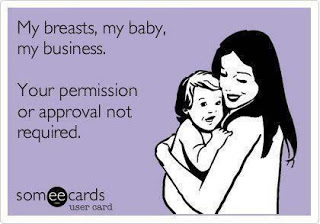
1. One can wean off a ventilator using "Synchronous Intermittent Mandatory Ventilation": the ventilator provides a minimum of, say, 12 breaths a minute, and the patient supplies additional breaths. If all goes well, the machine delivers fewer breaths, and the patient breathes more and more on his or her own.
Similarly, the mother desperate for her body back may offer the breast for a reduced number of times or only fixed times a day. For example, 10pm, 4am, 7am, 5pm. Try telling that to the pacifier-rejecting baby who uses you as a human pacifier. All night long.
2. One can also use a T-piece (what it sounds like--T-shaped tubing), which replaces the ventilator and delivers humidified oxygen. The longer time the patient can tolerate without the ventilator, that's progress towards extubation (removal of intubation!) Nighttime weaning is not usually attempted until the patient can maintain spontaneous respirations most of the day.
Perhaps your toddler (who is way too old to be breastfeeding) will accept milk or water in a sippy cup, since she hates bottles and pacifiers with a passion. But as is true of T-pieces, even if the child lasts all day without breastfeeding, she will probably still scream bloody murder for boobies when she wakes up (ten times) at night.
3. Pressure Support Ventilation supplies less and less pressure with each breath, encouraging the patient to take over the work of breathing gradually.
Mom will probably produce less milk due to (depression and) baby being old enough to eat actual food during the day, so if baby can take over intake of nutrients without leeching off Mommy's bones and energy, that would be awesome. Just saying.
Yes, my child is almost seven and I'm done reproducing, but I'm still bitter, see? They should latch a few hungry babies all night long onto the WHO spokespeople advocating breastfeeding for the first two years of life, and see how fast they stop the lactation consultants from scaring sleepless new moms (with jobs and second shifts) with threats of SIDS (sudden infant death syndrome) and "nipple confusion" if the mothers don't breastfeed on demand, and exclusively.
Ultimately, though, the best advice to a new mom or any mom is probably this: Don't let people tell you what to do. Because they will try. And none of them have any idea. Do what works (and is safe) for you and your family.

Published on May 02, 2019 08:52
April 25, 2019
4.15. Pareto Principle = 80/20 rule
Italian economist Vilfredo Pareto first developed the 80/20 rule (aka the law of the vital few, or the principle of factor sparsity) from observing that approximately 80% of land in Italy was owned by 20% of the population.
The business world has long said that 80% of business comes from 20% of customers, and statisticians have noted that historically, 80% of events come from 20% of causes. 80% of traffic occupies 20% of roads, and perhaps nobody cares about this, but 80% of peas also come from 20% of pods, Mendel or no Mendel.
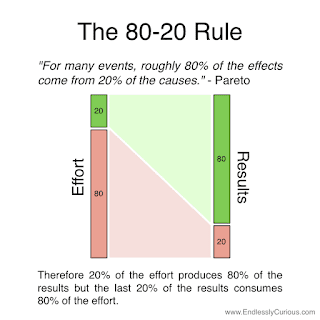 The Pareto Principle applies to healthcare in many ways. 80% of healthcare costs come from 20% of patients (same goes for readmissions), and along the same vein, 80% of clinical problems that arise throughout a shift come from 20% of patients. On the other hand, if we flip the rule, we also see that 20% of our efforts may produce 80% of effects. As nurses and medical professionals, we may prioritize the most critical and urgent 20% of tasks to produce 80% of results (and work towards preventing 80% of complications) any given day. The remainng 80% of tasks that will produce 20% of results, we'll try out best to get to, or delegate.
The Pareto Principle applies to healthcare in many ways. 80% of healthcare costs come from 20% of patients (same goes for readmissions), and along the same vein, 80% of clinical problems that arise throughout a shift come from 20% of patients. On the other hand, if we flip the rule, we also see that 20% of our efforts may produce 80% of effects. As nurses and medical professionals, we may prioritize the most critical and urgent 20% of tasks to produce 80% of results (and work towards preventing 80% of complications) any given day. The remainng 80% of tasks that will produce 20% of results, we'll try out best to get to, or delegate.
As normal people going about our business in real life, we may ask ourselves: "Of my mile-long, soulcrushingly overwhelming to-do list, what 20% of tasks will produce 80% of imperative and desired outcomes?" Paying bills on time helps, and meeting deadlines in general is good practice. Also, taking pills, getting nutrition and at least some sleep are essential to keeping our bodies functioning. Mopping and laundry can wait--unless you need that uniform tomorrow, in which case, it makes the cut.
In short, life is too short for us to sweat every tiny bit of the nonessential 80% when the more important 20% are urgently sounding alarms and requiring rapid responses. Take care of the big things first, and try your best. No one can do all the things, all the time.
The business world has long said that 80% of business comes from 20% of customers, and statisticians have noted that historically, 80% of events come from 20% of causes. 80% of traffic occupies 20% of roads, and perhaps nobody cares about this, but 80% of peas also come from 20% of pods, Mendel or no Mendel.
 The Pareto Principle applies to healthcare in many ways. 80% of healthcare costs come from 20% of patients (same goes for readmissions), and along the same vein, 80% of clinical problems that arise throughout a shift come from 20% of patients. On the other hand, if we flip the rule, we also see that 20% of our efforts may produce 80% of effects. As nurses and medical professionals, we may prioritize the most critical and urgent 20% of tasks to produce 80% of results (and work towards preventing 80% of complications) any given day. The remainng 80% of tasks that will produce 20% of results, we'll try out best to get to, or delegate.
The Pareto Principle applies to healthcare in many ways. 80% of healthcare costs come from 20% of patients (same goes for readmissions), and along the same vein, 80% of clinical problems that arise throughout a shift come from 20% of patients. On the other hand, if we flip the rule, we also see that 20% of our efforts may produce 80% of effects. As nurses and medical professionals, we may prioritize the most critical and urgent 20% of tasks to produce 80% of results (and work towards preventing 80% of complications) any given day. The remainng 80% of tasks that will produce 20% of results, we'll try out best to get to, or delegate.As normal people going about our business in real life, we may ask ourselves: "Of my mile-long, soulcrushingly overwhelming to-do list, what 20% of tasks will produce 80% of imperative and desired outcomes?" Paying bills on time helps, and meeting deadlines in general is good practice. Also, taking pills, getting nutrition and at least some sleep are essential to keeping our bodies functioning. Mopping and laundry can wait--unless you need that uniform tomorrow, in which case, it makes the cut.
In short, life is too short for us to sweat every tiny bit of the nonessential 80% when the more important 20% are urgently sounding alarms and requiring rapid responses. Take care of the big things first, and try your best. No one can do all the things, all the time.
Published on April 25, 2019 14:09
April 18, 2019
4.14. Mercy Medical Center = Dignity Health
Dignity Health’s slogan is “Hello Humankindness” and Mercy, the hospital next door (across the street, technically), our benefactor, our teacher, has been beyond kind to us Merced College nursing students.
 Let us count the ways.
Let us count the ways.
The ED taught us how assessment and nursing judgment is everything.
OB showed us the most amazing thing in life—the beginning of life itself.
The ICU reminds us what really matters: airway, breathing, circulation, disability, exposure, and family.
Telemetry highlights the science and wonder of the human heart.
5th floor (home of my awesome preceptor!) covers everything from anemia to Zollinger-Ellison syndrome, and cancer, too.
6th floor has procedures & drains & dressings galore, and all the assessments, too.
7th floor was where we as first semester Smurfs in royal blue, trembling in our hideous white shoes, first got our feet wet (sometimes literally).
We thank Dignity Health, Mercy Medical Center, for helping us grow from baby nurses to novice nurses over the past two years, for being there for all our firsts--first injection, first piggy, first birth--for being our home and family away from home.
Sincerely,
Merced College 4th Semester Registered Nursing students
 Let us count the ways.
Let us count the ways.The ED taught us how assessment and nursing judgment is everything.
OB showed us the most amazing thing in life—the beginning of life itself.
The ICU reminds us what really matters: airway, breathing, circulation, disability, exposure, and family.
Telemetry highlights the science and wonder of the human heart.
5th floor (home of my awesome preceptor!) covers everything from anemia to Zollinger-Ellison syndrome, and cancer, too.
6th floor has procedures & drains & dressings galore, and all the assessments, too.
7th floor was where we as first semester Smurfs in royal blue, trembling in our hideous white shoes, first got our feet wet (sometimes literally).
We thank Dignity Health, Mercy Medical Center, for helping us grow from baby nurses to novice nurses over the past two years, for being there for all our firsts--first injection, first piggy, first birth--for being our home and family away from home.
Sincerely,
Merced College 4th Semester Registered Nursing students
Published on April 18, 2019 09:19
April 14, 2019
4.13. Photo Essay: R = Resilient
Dear Mom,
It's been almost four years since you fell sick and passed. So much has changed since then, including me.
Sometimes I look in the mirror and startle because I think I see you. Something in the eyes, the lips that aren't quite certain but curl into a polite smile anyway, because it's what we've been taught.
 When you were my age you already had three children. I have just one, but she is everything (and more than enough).
When you were my age you already had three children. I have just one, but she is everything (and more than enough).
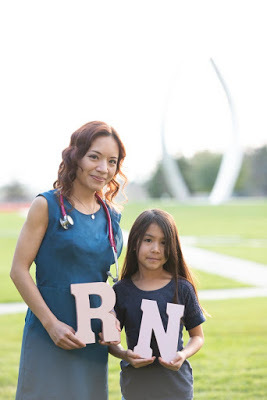 She gives me a reason to make responsible and strong decisions as a role model, because now it's about setting an example for what she should accept or not in her life one day.
She gives me a reason to make responsible and strong decisions as a role model, because now it's about setting an example for what she should accept or not in her life one day.
 Boundaries.
Boundaries.
Fist bump over hand shake.
Saying "no" and walking away and standing up, even when it feels uncomfortable or seems unthinkable, impossible.
 A belt is a belt is a belt. Sometimes a gait belt, sometimes punishment.
A belt is a belt is a belt. Sometimes a gait belt, sometimes punishment.
There have been a few.
We've lost a few matches in life, as well as a friend or two.
Leukemia, S. pneumoniae, HIV, all of them awful.
But life is suffering, and the big picture is this: life goes on.
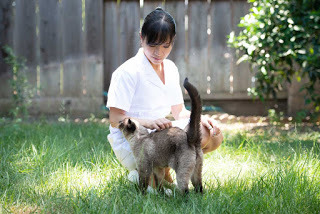 We made new friends as well, despite the misery, in spite of ourselves. Something to be said about bonding under heavier-than-usual atmospheric pressure. The universe makes matches and gravity and gravitation take place.
We made new friends as well, despite the misery, in spite of ourselves. Something to be said about bonding under heavier-than-usual atmospheric pressure. The universe makes matches and gravity and gravitation take place.
 The sun, rising after 6:30 am, when we're already in the hospital, lights up each pillar, hurdle, stage, semester. The brightest window of light (and relief) is the time at the end of a clinical day, the longest possible space and time from the next one.
The sun, rising after 6:30 am, when we're already in the hospital, lights up each pillar, hurdle, stage, semester. The brightest window of light (and relief) is the time at the end of a clinical day, the longest possible space and time from the next one.
 Though now we're deep in preceptorship, which means clustered days, sleepless nights, setting up new skeletons, good bones, current labs, target assessments, working on time management and client priority.
Though now we're deep in preceptorship, which means clustered days, sleepless nights, setting up new skeletons, good bones, current labs, target assessments, working on time management and client priority.
 Five more weeks and we'll have earned the R in RN: R for Registered, Resilient, and frankly, Relieved.
Five more weeks and we'll have earned the R in RN: R for Registered, Resilient, and frankly, Relieved.
 Photo credit: J. Juarez Photography.
Photo credit: J. Juarez Photography.
If anyone is interested in a graduation (or family) picture package, he's currently offering a limited-time special of $50 per one-hour shoot. Contact jason.r.juarez at gmail.com.
It's been almost four years since you fell sick and passed. So much has changed since then, including me.
Sometimes I look in the mirror and startle because I think I see you. Something in the eyes, the lips that aren't quite certain but curl into a polite smile anyway, because it's what we've been taught.
 When you were my age you already had three children. I have just one, but she is everything (and more than enough).
When you were my age you already had three children. I have just one, but she is everything (and more than enough).
 She gives me a reason to make responsible and strong decisions as a role model, because now it's about setting an example for what she should accept or not in her life one day.
She gives me a reason to make responsible and strong decisions as a role model, because now it's about setting an example for what she should accept or not in her life one day. Boundaries.
Boundaries.Fist bump over hand shake.
Saying "no" and walking away and standing up, even when it feels uncomfortable or seems unthinkable, impossible.
 A belt is a belt is a belt. Sometimes a gait belt, sometimes punishment.
A belt is a belt is a belt. Sometimes a gait belt, sometimes punishment.There have been a few.
We've lost a few matches in life, as well as a friend or two.
Leukemia, S. pneumoniae, HIV, all of them awful.
But life is suffering, and the big picture is this: life goes on.
 We made new friends as well, despite the misery, in spite of ourselves. Something to be said about bonding under heavier-than-usual atmospheric pressure. The universe makes matches and gravity and gravitation take place.
We made new friends as well, despite the misery, in spite of ourselves. Something to be said about bonding under heavier-than-usual atmospheric pressure. The universe makes matches and gravity and gravitation take place. The sun, rising after 6:30 am, when we're already in the hospital, lights up each pillar, hurdle, stage, semester. The brightest window of light (and relief) is the time at the end of a clinical day, the longest possible space and time from the next one.
The sun, rising after 6:30 am, when we're already in the hospital, lights up each pillar, hurdle, stage, semester. The brightest window of light (and relief) is the time at the end of a clinical day, the longest possible space and time from the next one. Though now we're deep in preceptorship, which means clustered days, sleepless nights, setting up new skeletons, good bones, current labs, target assessments, working on time management and client priority.
Though now we're deep in preceptorship, which means clustered days, sleepless nights, setting up new skeletons, good bones, current labs, target assessments, working on time management and client priority. Five more weeks and we'll have earned the R in RN: R for Registered, Resilient, and frankly, Relieved.
Five more weeks and we'll have earned the R in RN: R for Registered, Resilient, and frankly, Relieved. Photo credit: J. Juarez Photography.
Photo credit: J. Juarez Photography.If anyone is interested in a graduation (or family) picture package, he's currently offering a limited-time special of $50 per one-hour shoot. Contact jason.r.juarez at gmail.com.
Published on April 14, 2019 21:41
April 4, 2019
4.12. How to Make a Book Trailer (For Free!)
1. Get a trailer, preferably secondhand.2. Fill it with books.
Okay, just kidding. It's actually even easier than that (and free!) to make your own book trailer. Here's how.
1. Find some images (including your book's cover image) that you like, and pick a bit of text to go with each image. The text could be exerpts from the book, praise, brief author bio, or general "tease"s or hooks to intrigue potential readers/buyers.
2. If you use Windows, the former Windows Movie Maker has been replaced by Photos, which is also free. If you use Apple, iMovie will do.
3. Create a new movie project in either platform. In Microsoft, add images to your project library and drag and drop them to your storyboard, where you can set duration (e.g. 5 seconds) and add text. In Apple, import images/videos, drag and drop into the film reel, and add captions.
4. In my case, I liked the captions in Microsoft Photos but hated the special effect, so I had to go to someone's house that had a Mac and use their iMovie to trim off the special effects (the drag-and-trim function is amazing, like virtual scissors on film reel). You can also add audio here, but I skipped that because I was planning on using Youtube's license-free music.
5. In Photos, export/share to create a video file to upload to Youtube. IMovie shares directly to Youtube. If you want, you can add music to your video using video editor in Youtube, and then download your video again for future use (complete with license-free music) using y2mate (https://y2mate.com/youtube/). (No funny apps or programs to install--enter your video address and it lets you download the mp4 file.)
6. My results are below. The whole thing took one manic evening, though the watercolors were done years ago, and I'm really glad they've finally been put to good use!
Okay, just kidding. It's actually even easier than that (and free!) to make your own book trailer. Here's how.
1. Find some images (including your book's cover image) that you like, and pick a bit of text to go with each image. The text could be exerpts from the book, praise, brief author bio, or general "tease"s or hooks to intrigue potential readers/buyers.
2. If you use Windows, the former Windows Movie Maker has been replaced by Photos, which is also free. If you use Apple, iMovie will do.
3. Create a new movie project in either platform. In Microsoft, add images to your project library and drag and drop them to your storyboard, where you can set duration (e.g. 5 seconds) and add text. In Apple, import images/videos, drag and drop into the film reel, and add captions.
4. In my case, I liked the captions in Microsoft Photos but hated the special effect, so I had to go to someone's house that had a Mac and use their iMovie to trim off the special effects (the drag-and-trim function is amazing, like virtual scissors on film reel). You can also add audio here, but I skipped that because I was planning on using Youtube's license-free music.
5. In Photos, export/share to create a video file to upload to Youtube. IMovie shares directly to Youtube. If you want, you can add music to your video using video editor in Youtube, and then download your video again for future use (complete with license-free music) using y2mate (https://y2mate.com/youtube/). (No funny apps or programs to install--enter your video address and it lets you download the mp4 file.)
6. My results are below. The whole thing took one manic evening, though the watercolors were done years ago, and I'm really glad they've finally been put to good use!
Published on April 04, 2019 00:33
How to Make a Book Trailer (For Free!)
1. Get a trailer, preferably secondhand.2. Fill it with books.
Okay, just kidding. It's actually even easier than that (and free!) to make your own book trailer. Here's how.
1. Find some images (including your book's cover image) that you like, and pick a bit of text to go with each image. The text could be exerpts from the book, praise, brief author bio, or general "tease"s or hooks to intrigue potential readers/buyers.
2. If you use Windows, the former Windows Movie Maker has been replaced by Photos, which is also free. If you use Apple, iMovie will do.
3. Create a new movie project in either platform. In Microsoft, add images to your project library and drag and drop them to your storyboard, where you can set duration (e.g. 5 seconds) and add text. In Apple, import images/videos, drag and drop into the film reel, and add captions.
4. In my case, I liked the captions in Microsoft Photos but hated the special effect, so I had to go to someone's house that had a Mac and use their iMovie to trim off the special effects (the drag-and-trim function is amazing, like virtual scissors on film reel). You can also add audio here, but I skipped that because I was planning on using Youtube's license-free music.
5. In Photos, export/share to create a video file to upload to Youtube. IMovie shares directly to Youtube. If you want, you can add music to your video using video editor in Youtube, and then download your video again for future use (complete with license-free music) using y2mate (https://y2mate.com/youtube/). (No funny apps or programs to install--enter your video address and it lets you download the mp4 file.)
6. My results are below. The whole thing took one manic evening, though the watercolors were done years ago, and I'm really glad they've finally been put to good use!
Okay, just kidding. It's actually even easier than that (and free!) to make your own book trailer. Here's how.
1. Find some images (including your book's cover image) that you like, and pick a bit of text to go with each image. The text could be exerpts from the book, praise, brief author bio, or general "tease"s or hooks to intrigue potential readers/buyers.
2. If you use Windows, the former Windows Movie Maker has been replaced by Photos, which is also free. If you use Apple, iMovie will do.
3. Create a new movie project in either platform. In Microsoft, add images to your project library and drag and drop them to your storyboard, where you can set duration (e.g. 5 seconds) and add text. In Apple, import images/videos, drag and drop into the film reel, and add captions.
4. In my case, I liked the captions in Microsoft Photos but hated the special effect, so I had to go to someone's house that had a Mac and use their iMovie to trim off the special effects (the drag-and-trim function is amazing, like virtual scissors on film reel). You can also add audio here, but I skipped that because I was planning on using Youtube's license-free music.
5. In Photos, export/share to create a video file to upload to Youtube. IMovie shares directly to Youtube. If you want, you can add music to your video using video editor in Youtube, and then download your video again for future use (complete with license-free music) using y2mate (https://y2mate.com/youtube/). (No funny apps or programs to install--enter your video address and it lets you download the mp4 file.)
6. My results are below. The whole thing took one manic evening, though the watercolors were done years ago, and I'm really glad they've finally been put to good use!
Published on April 04, 2019 00:33
Sex & Taipei City Book Trailor
Finally found a use for those watercolors I did awhile back!
Published on April 04, 2019 00:33
March 28, 2019
Guest Post: How to Rock Your Nursing Resume by Karen Walcott
So you’re about to graduate Nursing School? Congratulations!!! Now you have to think about landing your first nursing job. Writing a resume can be daunting so let me offer you a few tips.
1. Don’t use a Microsoft Word Resume Template: Recruiters and Hiring Managers are very familiar with Word Templates. They are basic, generic, and unoriginal. You want your resume to stand out so don’t use the templates. They are plenty of other options out there. a. Canva: Creating a free account on this websitewill give you access to customizable resume templates with modern layouts. b. Etsy:There are a number of shops where you can purchase beautiful resume templates. There are even a few templates designed especially for nurses. Check out shops like Templates Design Company, Resume Template Studio, and Caps Look. Their nursing resume templates range in prices from $5-$15.
2. If you’re just graduating from nursing school and do not have any formal nursing experience than your resume should contain the following subject headings:a. Summary: This is where you begin to sell yourself. After all, a resume is a marketing tool and you are the product. In this paragraph you want to convince prospective employers why they should choose you. As a new grad you should discuss your short-term and/or long-term career goals, any specialized or advanced trainings or certifications that you hold, and any relevant experience.b. Licenses and Certifications: You should note if you have your EKG or a certification like ACLS.c. Education: Obviously as a new grad this is going to be an important section. You should mention the type of degree that you earned, i.e., was it an Associate’s degree or a Bachelor of Nursing degree. Then you should note the college or university that granted the degree, and your date of graduation. You should also mention any other degrees that you hold even if they are not nursing degrees. You should never be humble about your level of education. Sample Education Section:Associates Degree in Registered Nursing, Merced College, Merced, CA, May 2019Master’s in Fine Arts in English, Pennsylvania State University, State College, PA, 2006Bachelor of Arts in Foreign Languages and Literature, National Taiwan University, Taipei, Taiwan, June 2003d. Clinical Rotations: You should state where you did your clinical rotations and any trainings that you received or conferences that you attended during those rotations.If this whole process feels overwhelming, you can always hire a professional resume writer. I’m currently running a sale through my website, Rock Your Resume. Normally a cover letter/resume package would cost about $250, but until the end of April 2019 that package is only $150. The package includes a lengthy phone or Skype consultation, and three versions of your resume and cover letter, (MS Word, PDF, and ATS format). If you need help, please feel free to reach out. Thanks for reading.
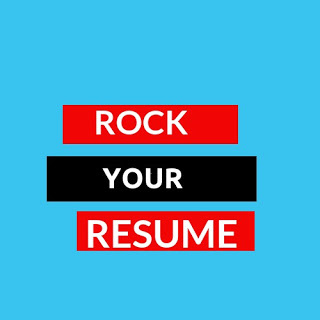
1. Don’t use a Microsoft Word Resume Template: Recruiters and Hiring Managers are very familiar with Word Templates. They are basic, generic, and unoriginal. You want your resume to stand out so don’t use the templates. They are plenty of other options out there. a. Canva: Creating a free account on this websitewill give you access to customizable resume templates with modern layouts. b. Etsy:There are a number of shops where you can purchase beautiful resume templates. There are even a few templates designed especially for nurses. Check out shops like Templates Design Company, Resume Template Studio, and Caps Look. Their nursing resume templates range in prices from $5-$15.
2. If you’re just graduating from nursing school and do not have any formal nursing experience than your resume should contain the following subject headings:a. Summary: This is where you begin to sell yourself. After all, a resume is a marketing tool and you are the product. In this paragraph you want to convince prospective employers why they should choose you. As a new grad you should discuss your short-term and/or long-term career goals, any specialized or advanced trainings or certifications that you hold, and any relevant experience.b. Licenses and Certifications: You should note if you have your EKG or a certification like ACLS.c. Education: Obviously as a new grad this is going to be an important section. You should mention the type of degree that you earned, i.e., was it an Associate’s degree or a Bachelor of Nursing degree. Then you should note the college or university that granted the degree, and your date of graduation. You should also mention any other degrees that you hold even if they are not nursing degrees. You should never be humble about your level of education. Sample Education Section:Associates Degree in Registered Nursing, Merced College, Merced, CA, May 2019Master’s in Fine Arts in English, Pennsylvania State University, State College, PA, 2006Bachelor of Arts in Foreign Languages and Literature, National Taiwan University, Taipei, Taiwan, June 2003d. Clinical Rotations: You should state where you did your clinical rotations and any trainings that you received or conferences that you attended during those rotations.If this whole process feels overwhelming, you can always hire a professional resume writer. I’m currently running a sale through my website, Rock Your Resume. Normally a cover letter/resume package would cost about $250, but until the end of April 2019 that package is only $150. The package includes a lengthy phone or Skype consultation, and three versions of your resume and cover letter, (MS Word, PDF, and ATS format). If you need help, please feel free to reach out. Thanks for reading.

Published on March 28, 2019 21:33



